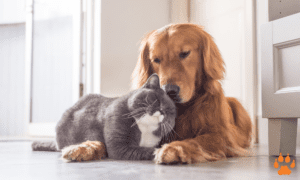By: Dr. Veja Tillman, DVM
Gingivitis is the same for pets as it is in people. Knowing what this disease is and how to recognize, prevent and treat it is an important step in ensuring your pet a happy healthy life.
Gingivitis is an infection caused by the build-up of food, plaque, and saliva on the surface of the teeth around the gums. The bacteria in plaque irritate the gum tissue when allowed to accumulate, which often leads to infection and inflammation of the gum tissue. Tartar is an advanced form of plaque that has hardened on the tooth surface. Tartar provides a rough surface that enhances further plaque build-up. Once tartar forms and grows, it is difficult to remove without dental instruments.
The most common cause of gingivitis is poor oral hygiene. Less commonly, gingivitis may develop secondary to systemic diseases (kidney disease, diabetes, etc.) and autoimmune diseases (such as pemphigus vulgaris).
Gingivitis is very common in dogs and cats. 70-80% of pets suffer with gingivitis in their lifetimes. Periodontitis is a more severe form of gingivitis that involves inflammation of the periodontal ligament (structure that holds the tooth in place) and bone, eventually causing loss of attachment of the tooth. Periodontitis is much more common in certain dog and cat breeds, but it can affect any dog or cat. While gingivitis is a reversible condition, periodontal disease can only be treated and not cured.
Signs that your pet may have gingivitis are bright red gums, swollen gums, excessive plaque and tartar buildup and bad breath. Yet, this is only the tip of the iceberg. The gums may become irritated leading to bleeding, oral pain and your pet may start to drop food from their mouth or lose his/her appetite. As the disease progresses, teeth may become loose and fallout. The bacteria present around the roots of the affected teeth may also enter the blood stream of the body leading to damage of the kidneys, heart muscle and liver.
Prevention of gingivitis is the same as its treatment: plaque removal and control. This is accomplished through routine brushing with a soft toothbrush or wiping of the teeth with a soft textured clothe. Some pets will not allow regular toothbrushing. So, when tartar is present routine dental cleaning of the teeth will give your pet a “dental reset” and help get you and your pet restart an oral hygiene routine.
Dental diets, toys, and treats can also help to decrease plaque and tartar on the surface of the teeth. Oral rinses and water additives may also be of benefit.
February is National Pet Dental Month!
Contact your veterinarian today to schedule a Complete Oral Health Assessment, Dental Cleaning and to discuss tooth brushing and dental products and diets.
About Dr. Veja Tillman, DVM
Dr. Tillman is a 2002 graduate of Tuskegee University School of Veterinary Medicine. Her veterinary practice and work experience focuses on patients at emergency and critical care centers in Southwest Florida. She is the owner of Just 4 Pets Wellness Center.








